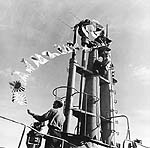The destruction of six Japanese submarines in 12 days by the destroyer escort USS England (story, P. 8) was truly one of themost remarkable feats in the history of naval warfare.
 However, in the cat-and-mouse game of submarine versus submarine, the USS Batfish (SS-310) takes top honors. Batfishsank three Japanese submarines in four days and severely hampered enemy efforts to evacuate valuable pilots, aircrews andground technicians from the Philippines to Takao on the island of Formosa.
However, in the cat-and-mouse game of submarine versus submarine, the USS Batfish (SS-310) takes top honors. Batfishsank three Japanese submarines in four days and severely hampered enemy efforts to evacuate valuable pilots, aircrews andground technicians from the Philippines to Takao on the island of Formosa.
In February 1945, the liberation of the Philippines was well underway, and the Imperial Japanese Air Force had beendecimated in the area. Without planes to fly, the pilots were useless. If they could reach Formosa to the west, they might atleast die for their emperor as kamikazes or fly defiant sorties against the Americans.
An ULTRA intelligence intercept made the exploits of Batfish possible. The February 6 bulletin from the office of theCommander in Chief, Pacific read in part: “This is ULTRA. Believe sub RO-46 will attempt evacuate personnel from N. Luzon8th between 2030 and 2130. Loading point 1000 m. west of Batulinao Point. Will be postponed one day if difficultyencountered.”
Commander J.K. Fyfe positioned Batfish, one of several submarines in the area, for an ambush. On the night of February 9,the submarine was patrolling the Babuyan Channel near the north coast of Luzon, the largest of the Philippine islands.Interference began to cloud the radar operator’s screen, and it became clear that another set of “eyes” was operating in thevicinity. No ship appeared on the screen, and Fyfe ordered his crew to “battle stations, torpedo,” playing out a hunch that itwas another submarine.
Batfish trailed its quarry northward and located a solid target at 11,000 yards. Closing to 1,800 yards, Fyfe still had not madevisual contact. Running on the surface, Batfish fired four torpedoes based on its radar information. All four missed. It quicklybecame apparent that the enemy submarine had increased its speed, but incredibly it seemed to remain oblivious to the stalkingAmerican boat.
Again moving into an attack position just after midnight on the 10th, Fyfe stayed bows-on with the enemy submarine,presenting as small a profile as possible against the night sky. At 1,000 yards the silhouette of a Japanese conning tower cameinto focus. The order to fire followed shortly,but the first torpedo hung in its tube and required a second attempt before hissing free. Two more torpedoes followed, andsec-onds later a fiery explosion marked the death of sub RO-115.
The next night, Batfish was again hunting in the Babuyan Channel. This time the victim was RO-112. Again, the Japanese radarsignals had vectored the American submarine to its rendezvous. Just as Fyfe prepared to fire, RO-112 submerged. Thirtyminutes later, the Japanese sub surfaced again. This time Fyfe fired four torpedoes by radar, one of which blew RO-112 out ofthe water.
On the night of February 12, Batfish dispatched RO-113 under similar circumstances. The target was acquired by radar,submerged, resurfaced and was hit by one of three radar-fired torpedoes. Fyfe and Batfish were the undisputed champions ofthe sub-versus-sub chess game. Ironically, RO-46, the submarine mentioned specifically in the ULTRA communiqu?, wasdelayed and successfully reached Takao on February 12 carrying a group of Japanese fliers.
Throughout the Pacific War, American submarines devastated Japanese merchant shipping, sinking a total of 5 million tons.They also sank 214 Japanese naval vessels. Of approximately 160 large Japanese submarines that saw service during WorldWar II, 127 were lost. As many as 20 may have been sunk by torpedo attacks from American submarines.
Two of four Japanese submarines that attempted the hazardous round trip from the Pacific to Europe were sunk by Alliedsubmarines. I-34 fell to the British sub Taurus, and I-29 was sunk by USS Sawfish. I-52 was the victim of U.S. aircraft. OnlyI-8 completed the trek. When it came to submarine-versus-submarine combat, though, Batfish was in a class by herself.




